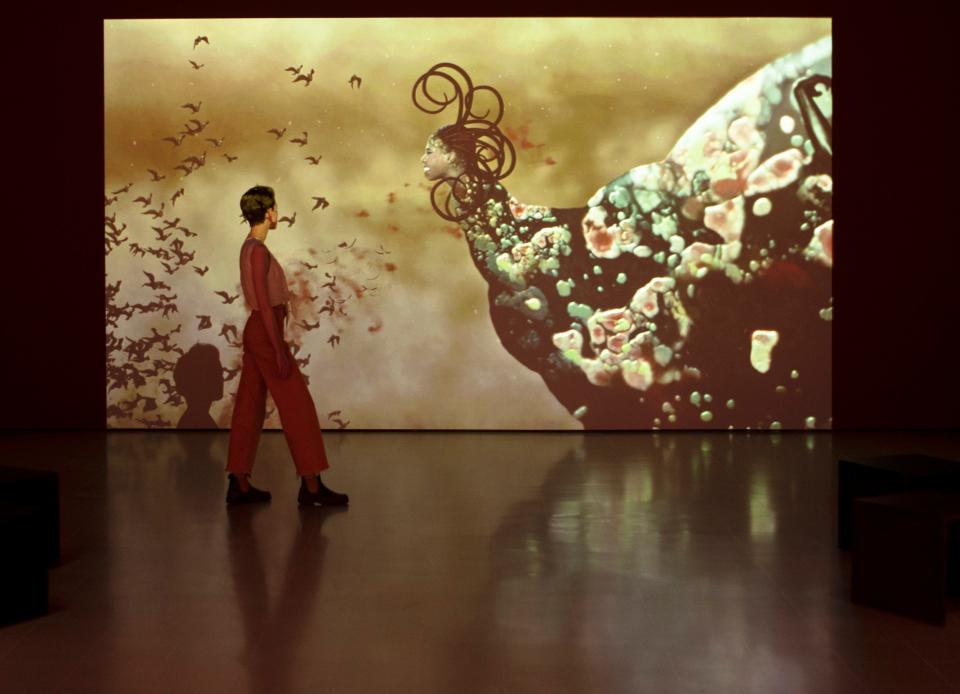In the Black Fantastic, review: upsetting, entertaining and intoxicating

- Oops!Something went wrong.Please try again later.
- Oops!Something went wrong.Please try again later.
It is two years since a white police officer in Minneapolis murdered an African-American man by kneeling on his neck for more than nine minutes. George Floyd’s death, and the Black Lives Matter movement to which it brought global attention, is explicitly invoked in curator Ekow Eshun’s forthright introduction to In the Black Fantastic, the Hayward Gallery’s by turns upsetting and entertaining new show of work by 11 contemporary artists “from the African diaspora”.
Eshun is blunt about “the long history of bigotry suffered by Black [sic] people in the West”, and, in the upper galleries, as ragtime plays, Kara Walker’s retro, animated cut-paper silhouettes dramatise atrocities by white supremacists, while, downstairs, the Confederate battle flag looms in a large picture by Sedrick Chisom.
And yet: this show is anything but sombre or recriminatory; instead, the prevailing mood is more carnival than wake. It opens with the confidence of a supermodel strutting down the catwalk, with several “wearable sculptures”, like motley suits of armour draped over mannequins, by the American sculptor Nick Cave: one looks like a Pearly King’s costume on to which an astronaut’s helmet, with a vortex of colourful bristles for a visor, has been fused.
Incensed by footage of police officers in Los Angeles beating Rodney King, Cave began the “Soundsuits” series to which they belong three decades ago. Yet, despite the traumas to which they allude (and, elsewhere in the gallery, a new work by Cave, Chain Reaction, consisting of interlinked resin casts of his forearm, calls to mind shackled slaves drowning during the Middle Passage), his hooded outfits have a decidedly surreal, festive quality. They set the show’s tone.
Indeed, the exhibition suggests that the current vogue for Surrealism, which is the central preoccupation of the 59th Venice Biennale, The Milk of Dreams, is set to linger for a while. “This is the domain of the Strange,” begins a quote reproduced prominently near the start by the Martiniquan Surrealist Suzanne Césaire: at every turn, for instance in the collages (and sculptures) of Kenyan-born Wangechi Mutu, which remind me of those crazy composite vegetable heads by the 16th-century Italian painter Giuseppe Arcimboldo, or the sinuous, loved-up nymphs and Homeric heroes of Chris Ofili’s imposing, gilded oil paintings, we encounter peculiar hybrid creatures, with caprine heads or angelic wings, summoning a beguiling sense of transformative midsummer magic. According to Eshun, though, all this “fantastical” work isn’t a form of “escapism”, but a response to society’s racism, proposing alternative modes of being.

If there is a common aesthetic, beyond the shared thematic interest in reshaping reality into something rich and strange, it is one of ornamentation and adornment, visual fabulousness and flair. A bit like, say, Cave’s highly embellished Soundsuits, or the intricate surfaces of Mutu’s collages encrusted with plastic pearls, Hew Locke’s four Ambassadors – sculptures of exuberantly attired horsemen, one wearing a camo Rastafarian hat – are festooned with glittering objects: cheap baubles and artificial flowers, “slave pennies”, colonial medals. With their psychedelic background patterns and 24-karat gold leaf, Lina Iris Viktor’s large-scale prints, meanwhile, in which she poses as an ancient prophetess, reinforce the overarching sense of sumptuousness.
The vision of contemporary blackness, then, which Eshun offers, is of a culture in its glad rags, determined, despite discrimination and prejudice, to be its best self. It is striking, while defining the “Black fantastic”, that he mentions two recent pop-culture hits: Beyoncé’s Lemonade and the superhero movie Black Panther. Check out the “swag” of the featured artists, he seems to be saying: this assertive, self-confident show is meant to project strength – and, like Barack Obama’s famously optimistic 2008 campaign slogan (“Yes We Can”), its message proves intoxicating.
It’s curious, because much of the work on display, such as those prints by Viktor, wouldn’t look out of place inside a glossy magazine. Here, though, all the performative fabulousness doesn’t come across as glib, but contributes to a party spirit that makes this exhibition surprisingly upbeat.
From Wednesday June 29 until Sept 18; southbankcentre.co.uk

